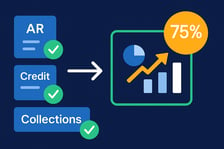A solid foundation is essential for building a successful business, and one of the most critical elements of that foundation is sound accounting practices. In this article, we’ll focus on how to create a strong small-business accounting foundation to ensure your financial health.
Always have a pro in your corner
While it’s possible to run a small business by yourself, it's undoubtedly a more challenging path. Building a knowledgeable team around you is a smarter approach. If you're running a one-person operation, you're essentially working in isolation, and solving problems on your own can slow down progress.
The same principle applies to accounting. Managing finances on your own can quickly become overwhelming, especially when you consider the complexity of financial statements, tax filings, and keeping up with changing tax laws. This is why hiring the right accounting professionals is key to ensuring accuracy and peace of mind.
A Certified Public Accountant (CPA) is an excellent choice, particularly for business owners just starting out. CPAs can handle a wide range of tasks, including resolving complex accounting issues and filing taxes. If you need someone to manage the day-to-day accounting, a bookkeeper is the ideal person to bring on board. A good CPA can also provide a referral to a skilled bookkeeper who can ensure your daily finances are in order.
Additionally, with the rise of cloud-based accounting tools, many small businesses now have access to affordable software that can simplify bookkeeping tasks. However, even with the right tools, it's still important to have a professional guide you through the complexities of tax planning and financial strategy.
Choosing accounting software
Choosing accounting software that is popular and compatible with the majority of accountants can make life a whole lot easier than choosing a lesser-known, off-brand package. Unless you have a specific reason to go with a lesser-known package, staying with the mainstream is a better decision.
Also, check that the accounting software you choose allows accountants to connect in remotely, which is now common practice.
Choose the right accounting method
To be accrual or to be cash, that is the question. If you invoice customers or pay suppliers on net terms, you’ll be using accrual accounting. If products are sold and paid for immediately, cash accounting can work. Of course, speak with your accountant before making any decision.
In some cases, the IRS has already made the decision for you. If you have inventory or your business is manufacturing, accrual accounting must be used.
Know your financial statements forward and backward
Your business has a special way of communicating its financial health to you. This is done through financial statements. Learning what each of these does will help you stay on top of your business’ financial performance. There are three financial statements:
Income Statement:
Sometimes called the P/L (profit and loss) statement, it shows how much money you are taking in, spending, and if you are generating a profit.
Balance Sheet:
Shows how much your business is worth from a purely financial standpoint. All of your assets and liabilities are listed here.
Cash Flow Statement:
Shows how much cash came in and went out of the business during a specific time period.
When looking at the income statement over time, it can be used to create trends and identify small problems before they become big problems. For example, it can help you see if revenue is increasing or decreasing, and how seasonal is it. You can also see trends in expenses, which can show areas within the business that are decreasing in efficiency. You don't have to do any of this by hand. Reports from accounting software will do it for you.
The balance sheet is a current snapshot of the business. It will show if you are overweight in debt, how much of the business is tied up in buildings or inventory, and more. It’s basically a breakdown of how the business is allocated by assets, liabilities, and equity.
Finally, there is the cash flow statement. The cash flow statement is useful for understanding what happened to cash that came into the business during a defined range of time. For example, starting on April 1, $500,000 of cash went into the business, and on June 30, $200,000 went out. Looking at the cash flow statement will tell you how that money flowed through the business and what used it.
Internal controls will make or break your business
If cash is the lifeblood of any business, then internal controls are the government that keeps a business from turning into anarchy. Creating a policy that outlines how accounts receivable works, which employee is assigned to which task, and how old payment collections are handled, will prevent employees from coming up with their own processes. New employees will learn the accounting process much more quickly when they have a document to follow and are able to get help from coworkers who all follow the same process.
It’s not enough though to create a well-defined process. It must be enforced and continuously updated, as well. Any document created for an accounting policy is a living document. The first version of the document is never the last.
Always pay your quarterly taxes
Some businesses never pay their quarterly taxes and wonder why they end up with such a large tax bill when their taxes are filed. Additionally, not paying quarterly taxes can result in penalties.
Paying quarterly taxes are part of running a business. Also, if you don’t pay them and instead believe you’ll have the money to pay at the end of the year, don’t be surprised if that plan doesn’t work out. Paying business taxes each quarter is not only good practice, but it also prevents unexpected surprises at tax time.





